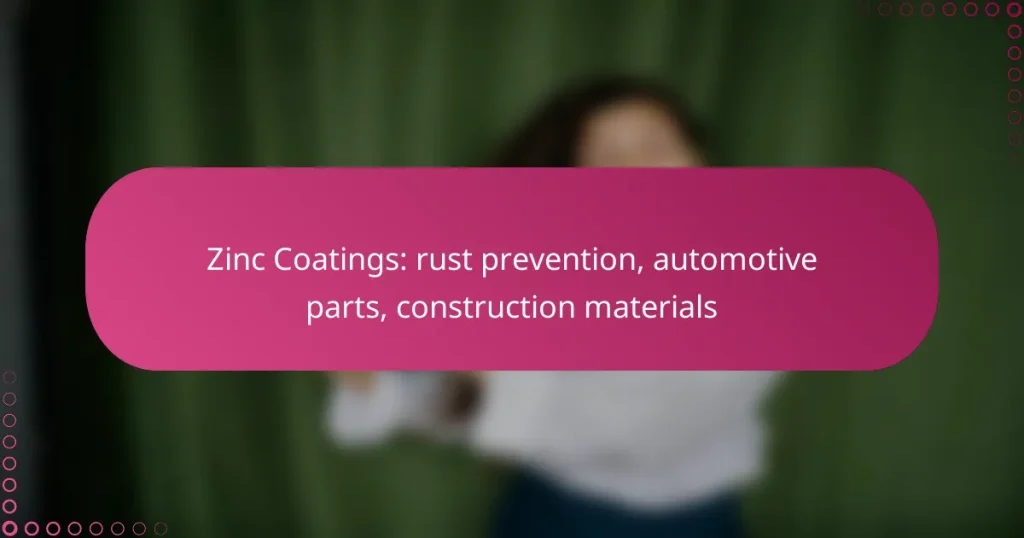Zinc coatings play a crucial role in rust prevention for automotive parts and construction materials by creating a protective barrier against moisture and corrosive elements. By acting as a sacrificial anode, zinc extends the lifespan of components, making it an essential choice for enhancing durability in various environments. Selecting the appropriate zinc coating requires careful consideration of application-specific factors, including environmental conditions and material types, to ensure optimal performance and compliance with industry standards.
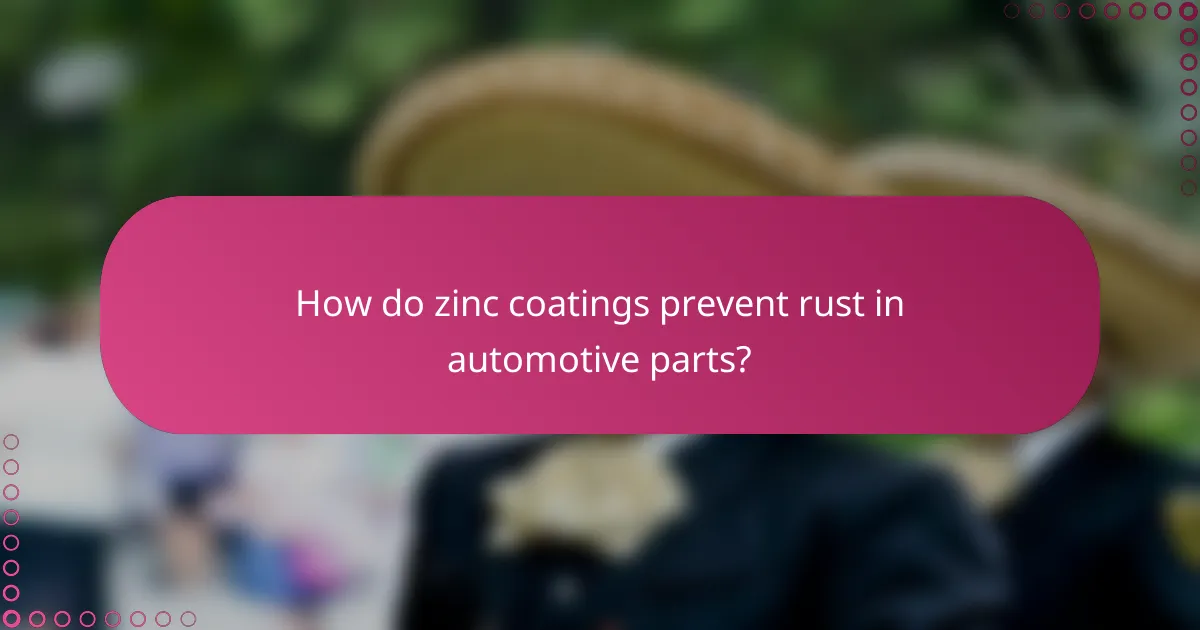
How do zinc coatings prevent rust in automotive parts?
Zinc coatings prevent rust in automotive parts by providing a protective barrier against moisture and corrosive elements. The zinc acts as a sacrificial anode, corroding in place of the underlying metal, thus extending the lifespan of the components.
Corrosion resistance properties
Zinc coatings are highly effective due to their electrochemical properties. When exposed to moisture, zinc oxidizes and forms a protective layer that inhibits further corrosion of the underlying metal. This process is particularly beneficial in environments with high humidity or exposure to road salts.
The thickness of the zinc layer can vary, typically ranging from 40 to 100 microns, which influences the level of corrosion resistance. Thicker coatings generally provide better protection, especially in harsh conditions.
Application methods for automotive parts
There are several methods for applying zinc coatings to automotive parts, including hot-dip galvanizing, electroplating, and thermal spraying. Hot-dip galvanizing involves immersing the parts in molten zinc, creating a robust bond and a thick coating.
Electroplating, on the other hand, uses an electric current to deposit a thin layer of zinc onto the metal surface, suitable for parts requiring a smoother finish. Thermal spraying involves spraying molten zinc onto the surface, which is effective for larger components.
Benefits of zinc coatings in vehicles
The primary benefit of zinc coatings in vehicles is enhanced durability against rust, which can lead to costly repairs and reduced vehicle lifespan. By protecting critical components such as chassis and suspension parts, zinc coatings help maintain vehicle integrity.
Additionally, zinc coatings can improve the resale value of vehicles by preserving their appearance and structural integrity. They also require minimal maintenance, making them a cost-effective solution for rust prevention in automotive applications.
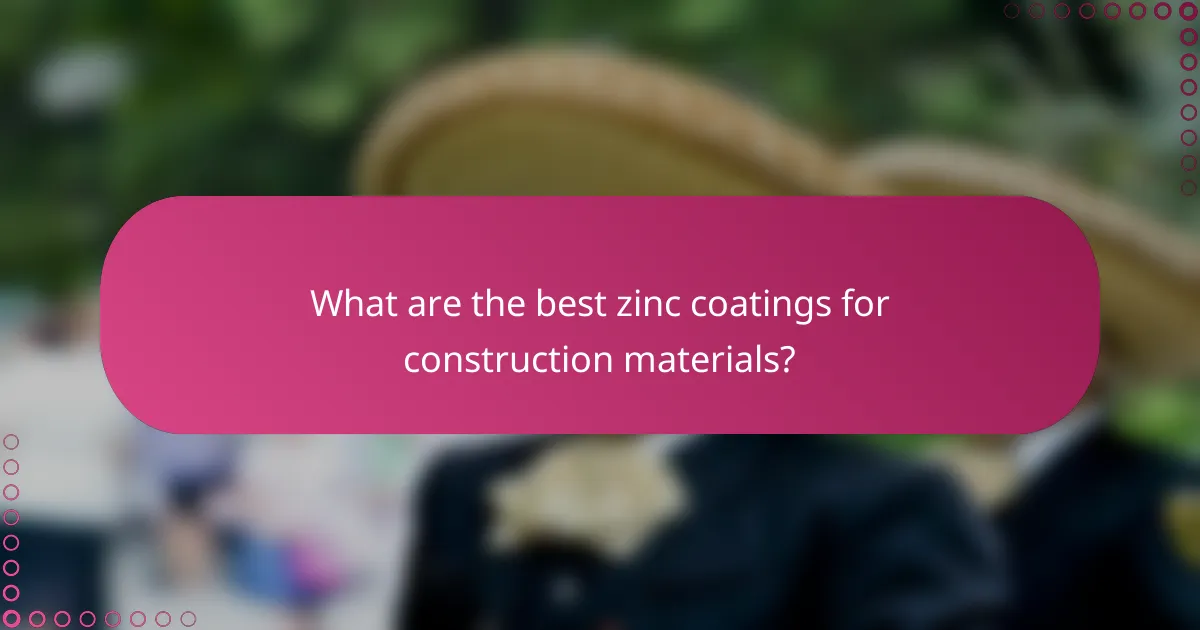
What are the best zinc coatings for construction materials?
The best zinc coatings for construction materials include hot-dip galvanizing, electroplating, and zinc-rich paints. These coatings provide effective rust prevention and enhance the longevity of steel structures in various environments.
Types of zinc coatings for steel
There are several types of zinc coatings suitable for steel, each with unique properties. Hot-dip galvanizing involves immersing steel in molten zinc, creating a thick, durable layer that is ideal for outdoor applications. Electroplating uses an electric current to deposit a thin layer of zinc, suitable for indoor environments.
Zinc-rich paints contain a high percentage of zinc dust and are often used for touch-ups or as a final coat. They provide a protective barrier and are easy to apply, making them a popular choice for maintenance projects.
Durability of zinc coatings in construction
Zinc coatings are known for their durability, often lasting several decades under proper conditions. Hot-dip galvanizing can protect steel for 30 years or more, depending on the environment, while electroplated coatings typically last around 10-20 years.
Factors such as humidity, exposure to saltwater, and industrial pollutants can affect the longevity of zinc coatings. Regular inspections and maintenance can help identify any wear and ensure continued protection against rust.
Cost-effectiveness of zinc coatings
Zinc coatings are generally cost-effective solutions for rust prevention in construction. While the initial application costs may vary, the long-term savings from reduced maintenance and replacement costs can be significant. Hot-dip galvanizing may have a higher upfront cost but offers greater durability, making it a wise investment.
When considering cost, it’s essential to factor in the specific environment and expected lifespan of the coating. For instance, in coastal areas, investing in more robust coatings may lead to lower overall expenses due to reduced corrosion rates.

How to choose the right zinc coating for your needs?
Choosing the right zinc coating involves understanding the specific requirements of your application, including environmental conditions and the type of materials involved. Consider factors such as durability, corrosion resistance, and compliance with industry standards to ensure optimal performance.
Factors to consider for automotive applications
In automotive applications, the zinc coating must withstand harsh conditions, including exposure to moisture, road salt, and varying temperatures. A common choice is hot-dip galvanizing, which provides a thick, protective layer that can last several years under typical driving conditions.
Additionally, consider the weight of the coating, as excessive thickness can affect vehicle performance. Look for coatings that meet industry standards like ISO 1461 for galvanizing to ensure reliability and safety.
Factors to consider for construction applications
For construction materials, the zinc coating should offer long-lasting protection against environmental factors such as humidity and pollutants. Electroplated zinc is often used for lighter structures, while hot-dip galvanizing is preferred for heavy-duty applications like steel beams and bridges.
It’s essential to evaluate the expected lifespan of the structure and local environmental conditions. In regions with high corrosion rates, thicker coatings may be necessary to meet standards such as ASTM A123 for hot-dip galvanizing, ensuring durability and compliance with safety regulations.
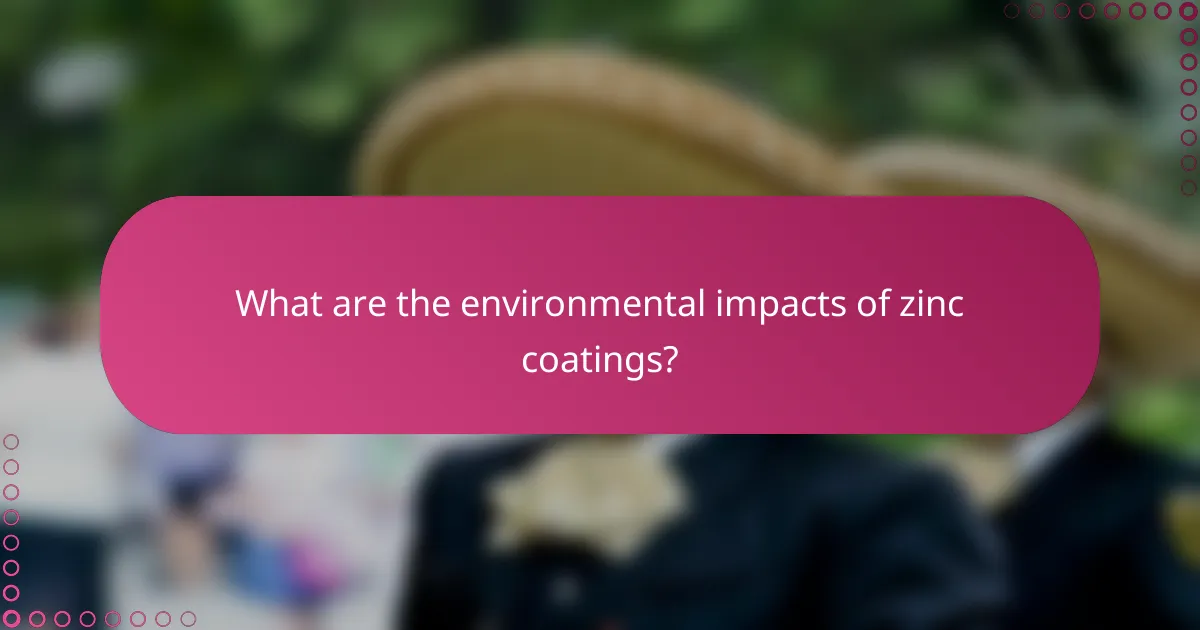
What are the environmental impacts of zinc coatings?
Zinc coatings can have both positive and negative environmental impacts. While they effectively prevent rust and extend the lifespan of materials, their production and eventual disposal can pose risks to ecosystems if not managed properly.
Recyclability of zinc-coated materials
Zinc-coated materials, such as galvanized steel, are generally recyclable. When these materials reach the end of their life cycle, they can be melted down and reused, reducing the need for new raw materials. This process often retains the beneficial properties of zinc, making it a sustainable choice for various applications.
However, the recyclability can be affected by the presence of other coatings or contaminants. It’s essential to ensure that zinc-coated scrap is processed correctly to maximize its recycling potential.
Impact on soil and water quality
The leaching of zinc from coatings into soil and water can impact local ecosystems. In moderate amounts, zinc is an essential micronutrient for plants and animals, but excessive concentrations can be toxic. Monitoring and managing zinc levels in industrial runoff is crucial to prevent soil and water contamination.
Regulatory frameworks often set limits on zinc discharge to protect environmental quality. For instance, in the EU, the Water Framework Directive outlines specific thresholds for zinc concentrations in water bodies to safeguard aquatic life.
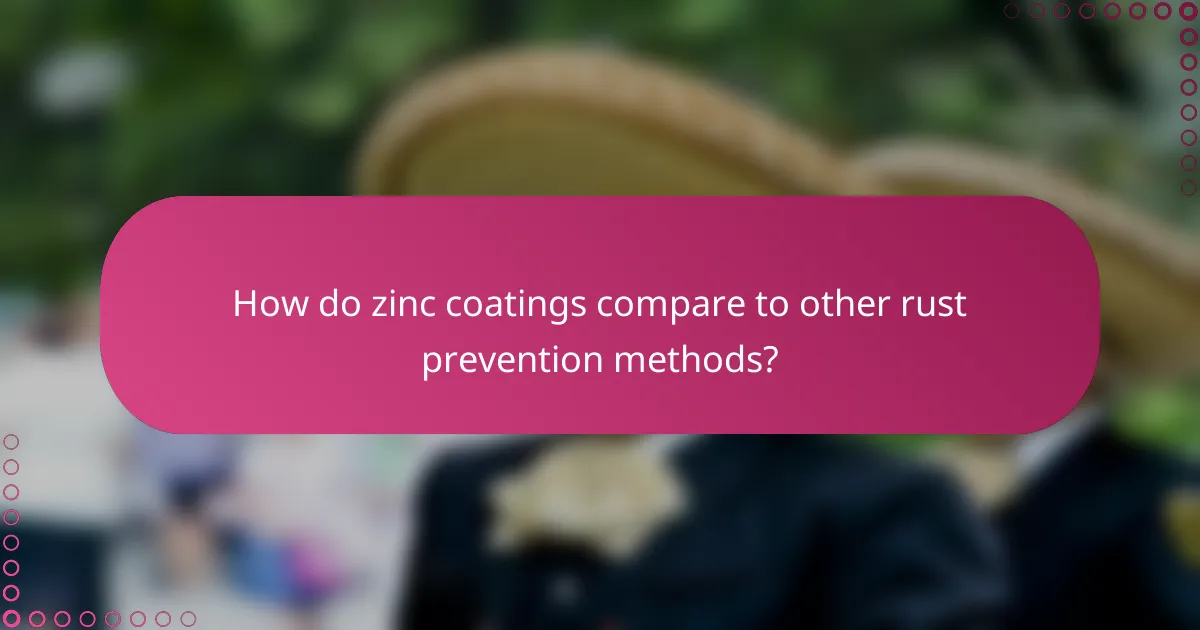
How do zinc coatings compare to other rust prevention methods?
Zinc coatings are an effective rust prevention method that offers unique advantages over alternatives like galvanization and paint coatings. They provide a sacrificial layer that protects underlying metals from corrosion, making them a popular choice in various applications, including automotive parts and construction materials.
Comparison with galvanization
Zinc coatings and galvanization both use zinc to protect metal surfaces, but they differ in application and effectiveness. Galvanization typically involves dipping steel into molten zinc, creating a thicker, more durable coating that is ideal for outdoor and heavy-duty applications. In contrast, zinc coatings can be applied through electroplating or spraying, resulting in a thinner layer that may be suitable for less demanding environments.
While galvanization offers superior protection against corrosion, it can be more expensive and less flexible in terms of application. Zinc coatings, on the other hand, are often easier to apply and can be used on complex shapes, making them a practical choice for automotive parts where weight and design complexity are considerations.
Comparison with paint coatings
Zinc coatings provide a different approach to rust prevention compared to paint coatings. While paint can offer aesthetic benefits and some level of corrosion resistance, it does not provide the same sacrificial protection as zinc. If the paint is scratched or damaged, the underlying metal is exposed and can corrode quickly.
In contrast, zinc coatings actively protect the metal by corroding first, which extends the life of the underlying material. For applications in harsh environments, zinc coatings are generally more reliable than paint, which may require frequent reapplication. However, paint can be more cost-effective for indoor applications where corrosion risk is lower.

What are the emerging trends in zinc coatings technology?
Emerging trends in zinc coatings technology focus on enhancing durability and environmental sustainability. Innovations are leading to more effective rust prevention methods while minimizing ecological impact.
Advancements in eco-friendly coatings
Eco-friendly zinc coatings are gaining traction as manufacturers seek to reduce their environmental footprint. These coatings often utilize non-toxic materials and sustainable practices, aligning with global regulations aimed at reducing hazardous substances.
For instance, some new formulations incorporate bio-based additives that enhance corrosion resistance without relying on harmful chemicals. This shift not only meets regulatory standards but also appeals to environmentally conscious consumers.
Innovations in application techniques
New application techniques for zinc coatings are improving efficiency and effectiveness. Methods such as thermal spraying and electroplating allow for more uniform coverage and better adhesion, which are critical for automotive parts and construction materials.
Additionally, advancements in robotic application systems are enabling precise and consistent coating processes, reducing waste and labor costs. These techniques can significantly enhance the longevity of coated surfaces, making them more resilient against rust and corrosion.
